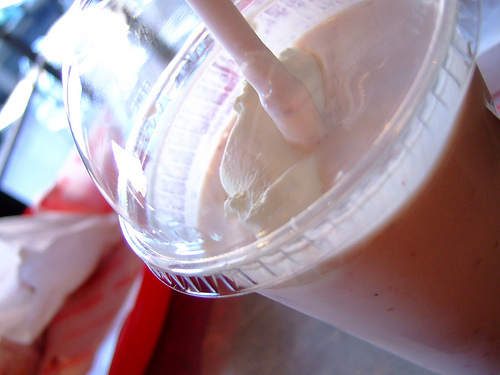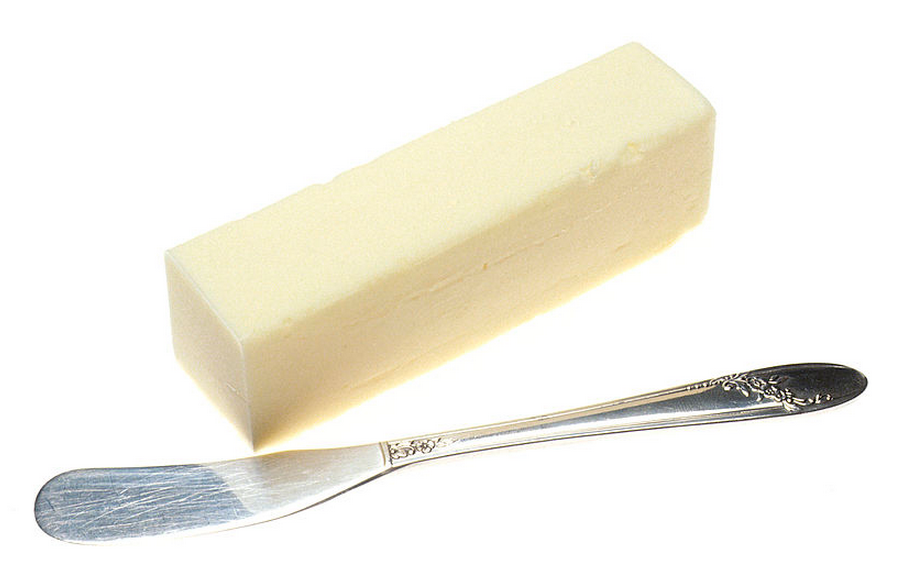
A Fast Food Shake, with far more than 4 ingredients. Photo Credit: yosoynuts
There are a lot of recommendations out there for what kinds of foods are good to purchase, or at least which kinds of foods are those that should be avoided, based on the ingredients list. **see NOTE at bottom before hand-wringing.
You’ll find admonishments to avoid:
Unfortunately, these rules run into some problems. Here are 3 reasons the “five ingredient” rule can be sending you down the wrong path to health.
1) Natural Flavor
You could eat a lot of questionable additives if following the “x” number of ingredients rule, even if it’s only five. One of the biggest culprits in this realm is “natural flavor” as an actual ingredient listed. Really? What, legally, can be in something called “natural flavor”? This is from the FDA’s website and is current as of 2013:
The term natural flavor or natural flavoring means the essential oil, oleoresin, essence or extractive, protein hydrolysate, distillate, or any product of roasting, heating or enzymolysis, which contains the flavoring constituents derived from a spice, fruit or fruit juice, vegetable or vegetable juice, edible yeast, herb, bark, bud, root, leaf or similar plant material, meat, seafood, poultry, eggs, dairy products, or fermentation products thereof, whose significant function in food is flavoring rather than nutritional.
So that means if you start with a “constituent” of a plant and then use enzymes OR heat OR roasting OR distillation OR extraction OR fermentation on it to produce something that will flavor a food, it’s “natural”. Yep. This is a massive industry, featured once in a while on investigative/hyped TV programs.
2) Food now ≠ food 50 years ago
If you follow the grandmother rule, you might eat food that LOOKS like real food but isn’t anything like it was 50 or 80 years ago. Wheat’s protein structure has changed quite a bit over the last 40 years (and that’s one of the theories about why wheat sensitivity is much higher now than ever before). Many factory farmed crops are genetically modified to grow in concert with amazingly complex biological killers (a.k.a. pesticides). And even simple ingredients, like “salt”, have been refined, processed, remolded, and stripped of their original minerals and physical form.
3) Ingredients with ingredients
In other words, five ingredients might not be five ingredients. There was a (rather reactionary oh-my-gawd-the-sky-is-falling) article several years back about the 59 ingredients in a McDonald’s strawberry milkshake that went moderately viral. The article delved into the 59 chemicals used to comprise the “strawberry flavor” part of the strawberry syrup. Each ‘ingredient’ was listed as the specific chemical compound name which, to many folks, sounds SCARY. Chemicals are not inherently scary. Everything is chemicals. If you listed all of the molecules in a banana by their chemical name you’d be freaked out. One of the chemicals that gives a banana its aroma is Amyl Acetate. If you take that chemical all by itself, it is a fruity-smelling solvent akin to nail polish remover. Eeeek! But it is in a banana, naturally. That’s why over-hyped articles like the “59 ingredients” one can be unhelpful. (**again, see NOTE at the bottom)
However, the non-molecular chemical ingredients are just as dubious. Note that when you initially see the list of ingredients for that milkshake, it is FOUR. That would be allowed under the “5 or less” rule, so what went wrong??? Here are the ingredients:
VANILLA REDUCED FAT ICE CREAM, STRAWBERRY SHAKE SYRUP, WHIPPED CREAM, MARASCHINO CHERRY
Hey, that’s not so bad . . . right? However, when you take each of those four ingredients and expand it – from the very same McDonald’s official pdf file – you end up with this:
VANILLA REDUCED FAT ICE CREAM (Milk, Sugar, Cream, Nonfat Milk Solids, Corn Syrup Solids, Mono- and Diglycerides, Guar Gum, Dextrose, Sodium Citrate, Artificial Vanilla Flavor, Sodium Phosphate, Carrageenan, Disodium Phosphate, Cellulose Gum, Vitamin A Palmitate.), STRAWBERRY SHAKE SYRUP (Sugar, Water, Corn Syrup, Strawberries, High Fructose Corn Syrup, Natural (Botanical Source) and Artificial Flavor, Pectin, Citric Acid, Potassium Sorbate (Preservative), Caramel Color, Calcium Chloride, Red 40), WHIPPED CREAM (Cream, Nonfat Milk, Corn Syrup, Sugar, High Fructose Corn Syrup, Contains Less Than 1%: Mono-And Diglycerides, Carrageenan, Polysorbate 80, Beta Carotene (Color), Natural (Dairy and Plant Sources) and Artificial Flavor, Mixed Tocopherols (Vitamin E) to Protect Flavor, and Whipping Propellant (Nitrous Oxide)), MARASCHINO CHERRY (Cherries, Water, Corn Syrup, High Fructose Corn Syrup, Sugar, Malic Acid, Citric Acid, Natural (Plant Source) and Artificial Flavors, Sodium Benzoate and Potassium Sorbate (Preservatives), Red 40, Sulfur Dioxide as Preservative (Contains Sulfites))
**POSTSCRIPT/NOTE

Now that’s a strawberry MILK shake! Photo Credit: A30_Tsitika
Here’s the flip side of this. Many of the “scary” sounding ingredients are simply the chemical names for compounds that could be individually present in real foods. In this case, they are also used in the artificial flavoring. Each of those chemicals is, by itself, neither good nor evil, and many of them are present in REAL fruit. HOWEVER. It does not change the fact that those ingredients were deliberately combined to make artificial flavor, as opposed to a strawberry growing on a plant and then being blended into the shake.
Stressing out about every thing you put in your mouth is also counterproductive to your health. What is important is having knowledge about real foods, and making choices in your life that are better than before, little by little. Moving from hot dogs to processed reformed deli meat to roasted sliced packaged meat to real/whole animals to organic animals to YOUR OWN animals is a process that has benefits at every step of the way, and you should feel good about each step, not just when you reach the end.
Armi Legge writes very well about this topic, especially his post called “The Myth of Clean Eating“. He straddles a nice divide between using real ingredients and not freaking out too much about straying off the path. Good job, dude!











